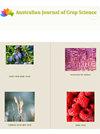Productive characteristics and structure of Paiaguás grass pasture fertilized with wood ash in the Brazilian Cerrado
Q3 Agricultural and Biological Sciences
引用次数: 0
Abstract
The use of wood ash as a fertilizer is a practice that helps in the management of soil fertility. Our objective was to evaluate the potential use of wood ash on structural and productive characteristics of paiaguás grass (Urochloa brizantha) pasture. The experiment was carried out at the Federal University of Rondonópolis, Brazilian Cerrado. Treatments were five wood ash doses: 0, 8, 16, 24, and 32 t ha-1 and two application strategies (wood ash incorporated into the soil and wood ash not-incorporated). Wood ash doses significantly affected (p<0.05) the evaluated response variables. Forage yield ranged from (mean ± standard error) 6.98±0.34 to 8.99±0.53 t DM ha-1. The highest productivity (11.10±0.46 t DM ha-1) was obtained at a wood ash rate of 24 t ha-1. The leaf area index was also higher (9.39±1.02) in the 24 t ha-1 wood ash dose. On the other hand, the leaf/stem ratio decreased with the application rate of wood ash and varied from 1.41±0.05 to 1.09±0.07 in the absence of wood ash (dose 0) and at the highest dose, respectively. In general, wood ash positively influenced (p<0.05) the structural characteristics and yield of U. brizantha cv. Paiaguás. Wood ash doses that provided the highest crop yield were between 16 and 24 t ha-1. The incorporation of wood ash into the soil increased pasture regrowth time. Therefore, it is recommended to apply wood ash superficially in established pastures.巴西塞拉多木灰施肥Paiaguás草地的生产特征和结构
使用木灰作为肥料是一种有助于管理土壤肥力的做法。我们的目的是评估木灰对paiaguás草(Urochloa brizantha)牧场结构和生产特性的潜在利用。这项实验是在巴西塞拉多的Rondonópolis联邦大学进行的。处理为5种木灰剂量:0、8、16、24和32 t hm -1,以及两种施用策略(木灰掺入土壤和不掺入土壤)。木灰剂量显著影响(p<0.05)评价的响应变量。饲料产量变化范围为(平均±标准误差)6.98±0.34 ~ 8.99±0.53 t DM hm -1。当木材灰分添加量为24 t hm -1时,产量最高(11.10±0.46 t DM hm -1)。24 t ha-1木灰处理的叶面积指数也较高(9.39±1.02)。另一方面,叶茎比随木灰施用量的增加而降低,在无木灰(剂量0)和最高剂量下分别为1.41±0.05 ~ 1.09±0.07。总体而言,木灰对棘花的结构特性和产量有正向影响(p<0.05)。Paiaguas。木灰用量在16 ~ 24吨公顷/公顷之间时,作物产量最高。在土壤中掺入木灰增加了牧草的再生时间。因此,建议在已建立的牧场表面施用木灰。
本文章由计算机程序翻译,如有差异,请以英文原文为准。
求助全文
约1分钟内获得全文
求助全文
来源期刊

Australian Journal of Crop Science
农林科学-农艺学
CiteScore
1.20
自引率
0.00%
发文量
75
审稿时长
3.5 months
期刊介绍:
Information not localized
 求助内容:
求助内容: 应助结果提醒方式:
应助结果提醒方式:


